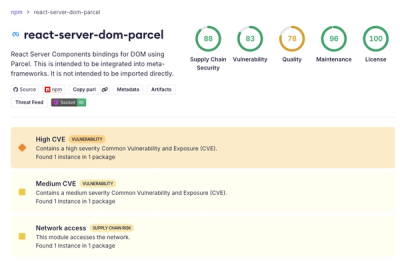
Security News
New React Server Components Vulnerabilities: DoS and Source Code Exposure
New DoS and source code exposure bugs in React Server Components and Next.js: what’s affected and how to update safely.
Lazy sequences
The list structure could be defined as
data Seq a = Nil | Cons a (Seq a)
The Cons constuctor takes two arguments, so there are four different laziness variants:
Cons (Strict a) (Strict (Seq a)) -- 1. fully strict
Cons (Lazy a) (Strict (Seq a)) -- 2. lazy values
Cons (Strict a) (Lazy (Seq a)) -- 3. lazy structure
Cons (Lazy a) (Lazy (Seq a)) -- 4. fully lazy
This module implements the third variant: lazy structure, but strict values.
var ones = lazyseq.cons(1, function () { return ones; });
console.log(ones === ones.tail()); // true!
This package is originally made to optimise shrink operations in jsverify, a property-based testing library.
nil : Seq a — Empty sequence.
cons : (head : a, tail : Array a | Seq a | () → Array a | () → Seq a) → Seq a : Cons a value to the front of a sequence (list or thunk).
.isNil : Boolean — Constant time check, whether the sequence is empty.
.toString : () → String — String representation. Doesn't force the tail.
.length : () → Nat — Return the length of the sequene. Forces the structure.
.toArray : () → Array a — Convert the sequence to JavaScript array.
.fold : (z : b, f : (a, () → b) → b) → b — Fold from right.
fold nil x f = x
fold (cons h t) x f = f x (fold t x f)
.head : () → a — Extract the first element of a sequence, which must be non-empty.
.tail : () → Seq a — Return the tail of the sequence.
tail nil = nil
tail (cons h t) = t
.nth : (n : Nat) → a — Return nth value of the sequence.
.take : (n : Nat) → Seq a — Take n first elements of the sequence.
.drop : (n : Nat) → Seq a — Drop n first elements of the sequence.
.map : (f : a → b) : Seq b — The sequence obtained by applying f to each element of the original sequence.
.append : (ys : Seq a | Array a) : Seq a — Append ys sequence.
.filter : (p : a -> bool) : Seq a — filter using p predicate.
*.every : (p = identity: a -> b) : b | true — return first falsy value in the sequence, true otherwise. N.B. behaves slightly differently from Array::every.
*.some : (p = identity: a -> b) : b | false — return first truthy value in the sequence, false otherwise. N.B. behaves slightly differently from Array::some.
*.contains : (x : a) : bool — Returns true if x is in the sequence.
*.containsNot : (x : a) : bool — Returns true if x is not in the sequence.
fromArray: (arr : Array a) → Seq a — Convert a JavaScript array into lazy sequence.
singleton: (x : a) → Seq a — Create a singleton sequence.
append : (xs... : Array a | Seq a | () → Array a | () → Seq a) → Seq a : Append one sequence-like to another.
iterate : (x : a, f : a → a) → Seq a — Create an infinite sequence of repeated applications of f to x: x, f(x), f(f(x))….
fold : (seq : Seq a | Array a, z : b, f : (a, () → b) → b) : b — polymorphic version of fold. Works with arrays too.
singleton constructure.contains, .containsNot, .every and .some methodsfilterappendfoldREADME.md is generated from the source with ljsmake test, yet travis will do it for you.FAQs
Lazy sequences
The npm package lazy-seq receives a total of 15,898 weekly downloads. As such, lazy-seq popularity was classified as popular.
We found that lazy-seq demonstrated a not healthy version release cadence and project activity because the last version was released a year ago. It has 1 open source maintainer collaborating on the project.
Did you know?

Socket for GitHub automatically highlights issues in each pull request and monitors the health of all your open source dependencies. Discover the contents of your packages and block harmful activity before you install or update your dependencies.

Security News
New DoS and source code exposure bugs in React Server Components and Next.js: what’s affected and how to update safely.

Security News
Socket CEO Feross Aboukhadijeh joins Software Engineering Daily to discuss modern software supply chain attacks and rising AI-driven security risks.

Security News
GitHub has revoked npm classic tokens for publishing; maintainers must migrate, but OpenJS warns OIDC trusted publishing still has risky gaps for critical projects.